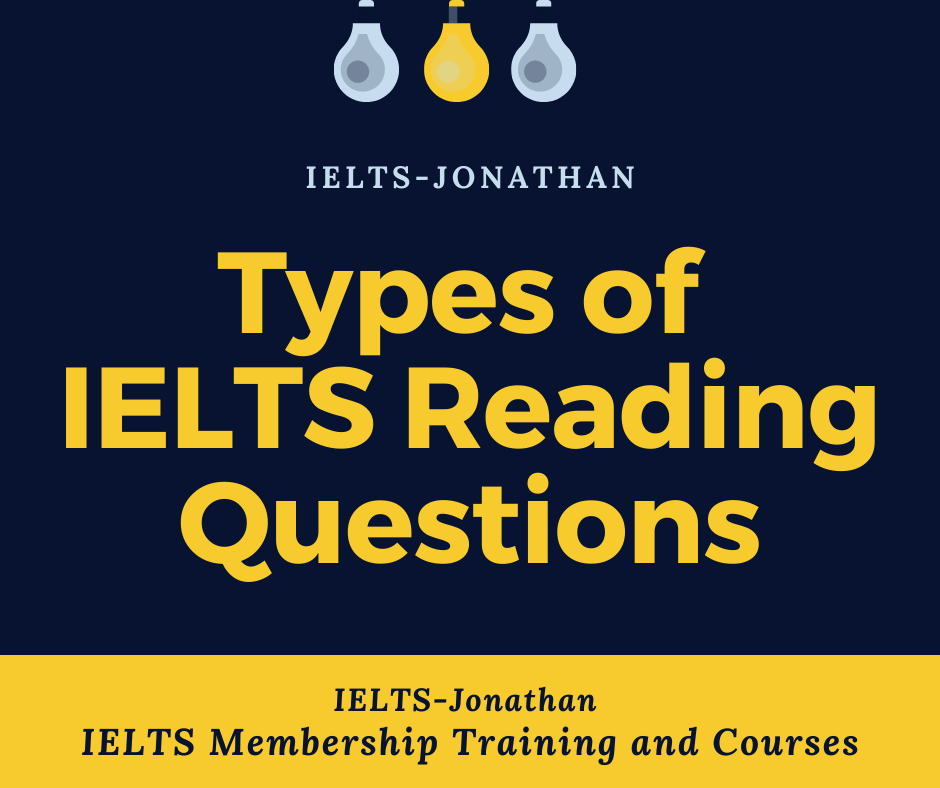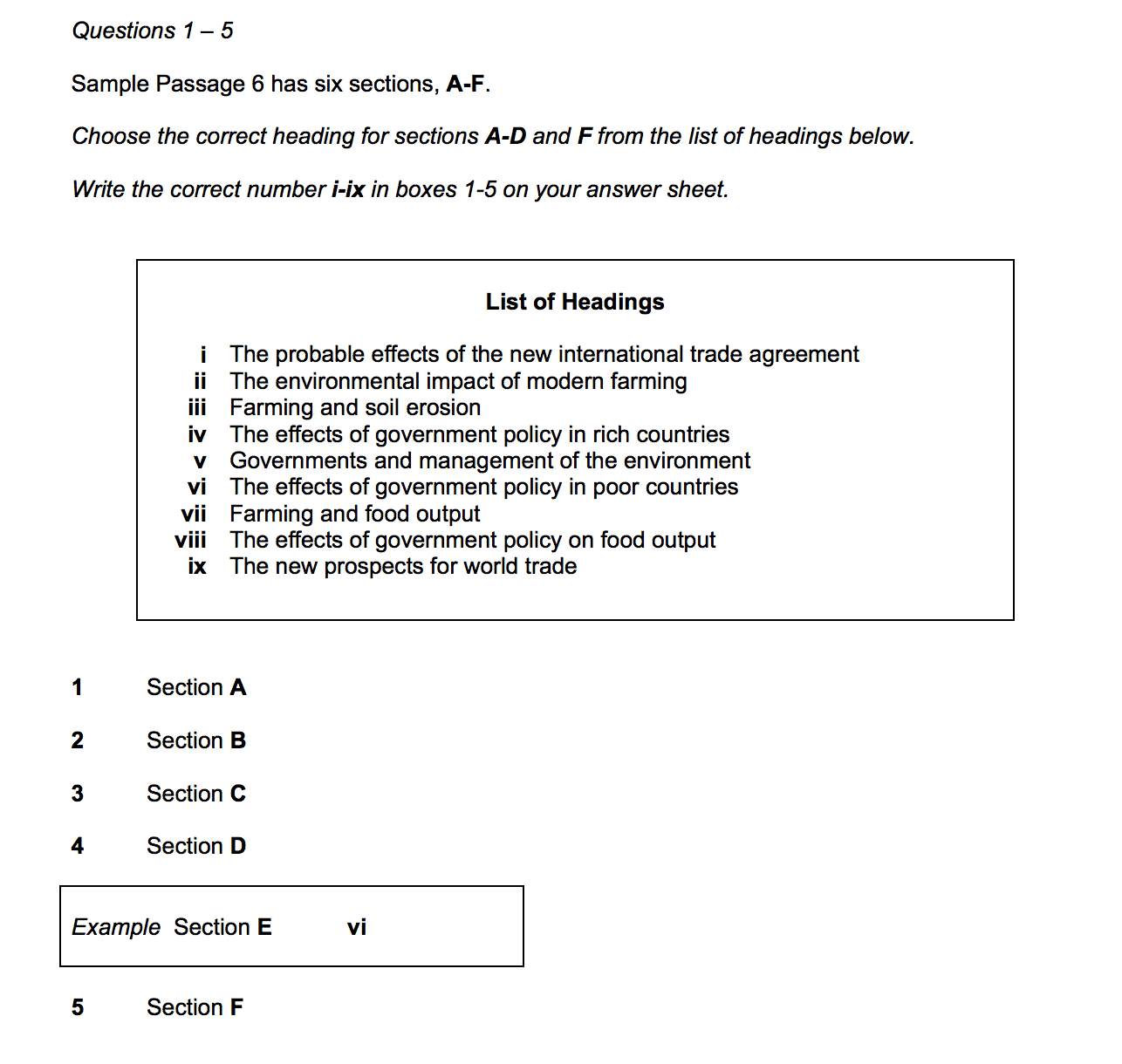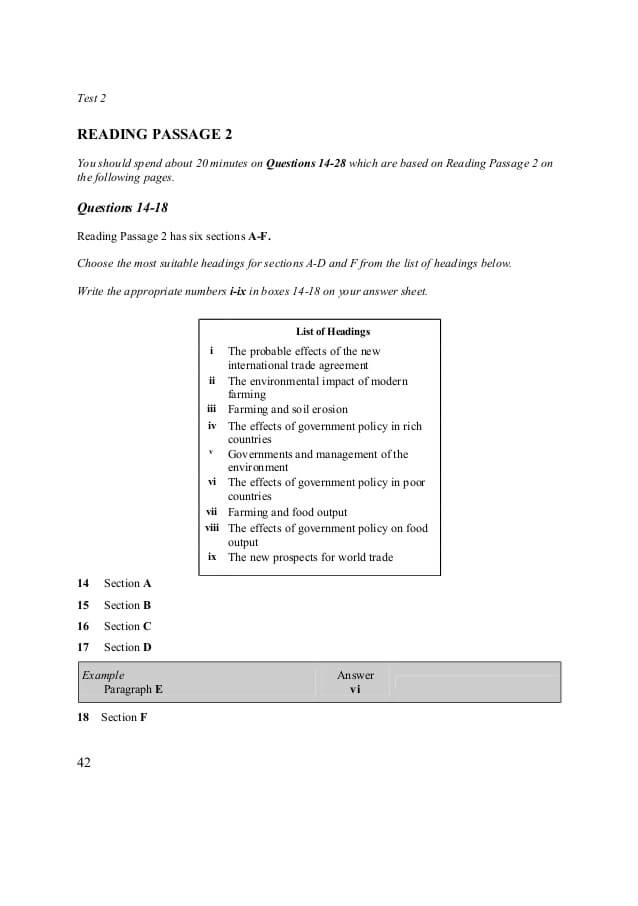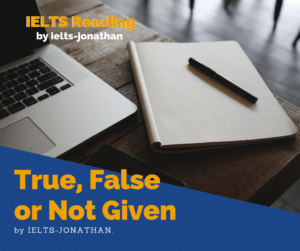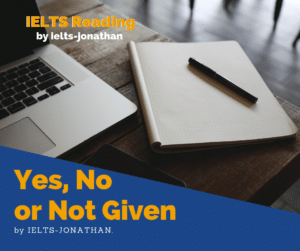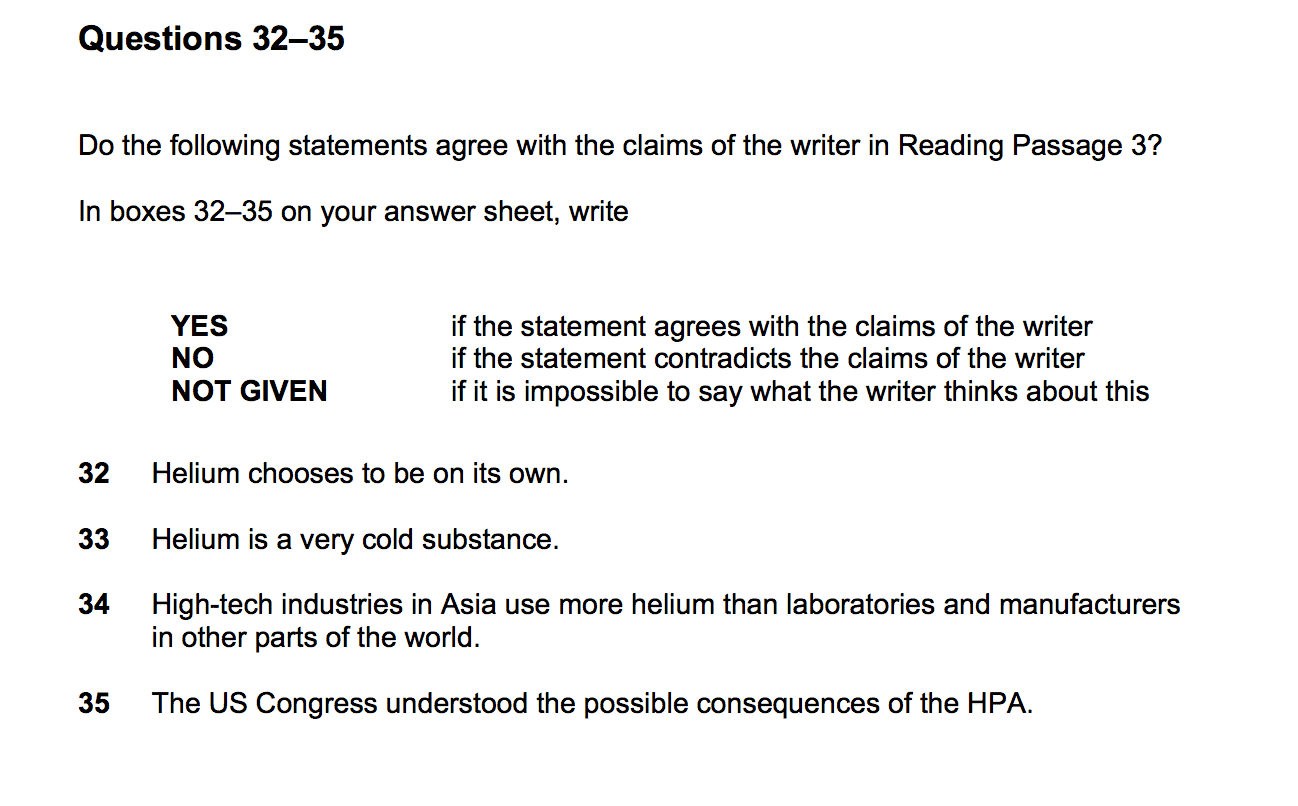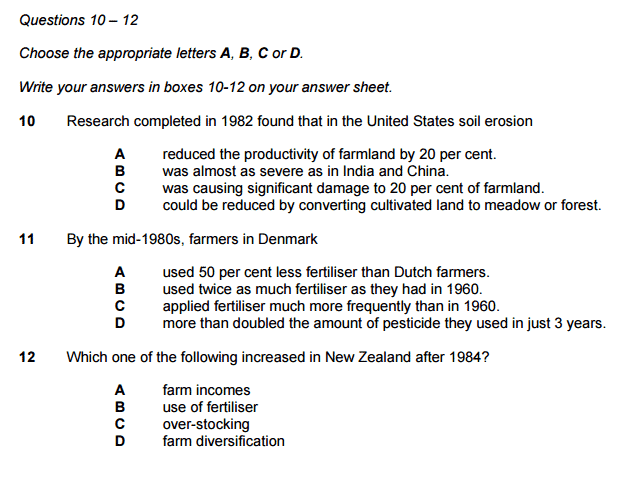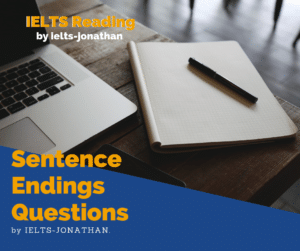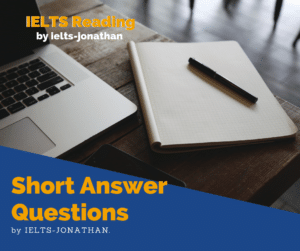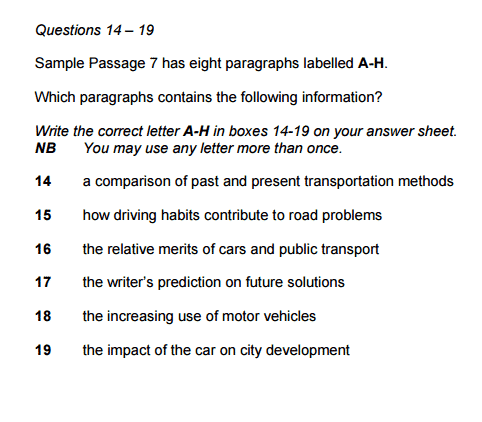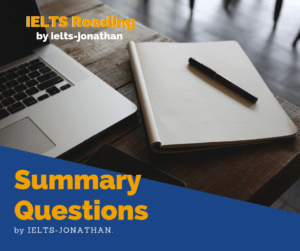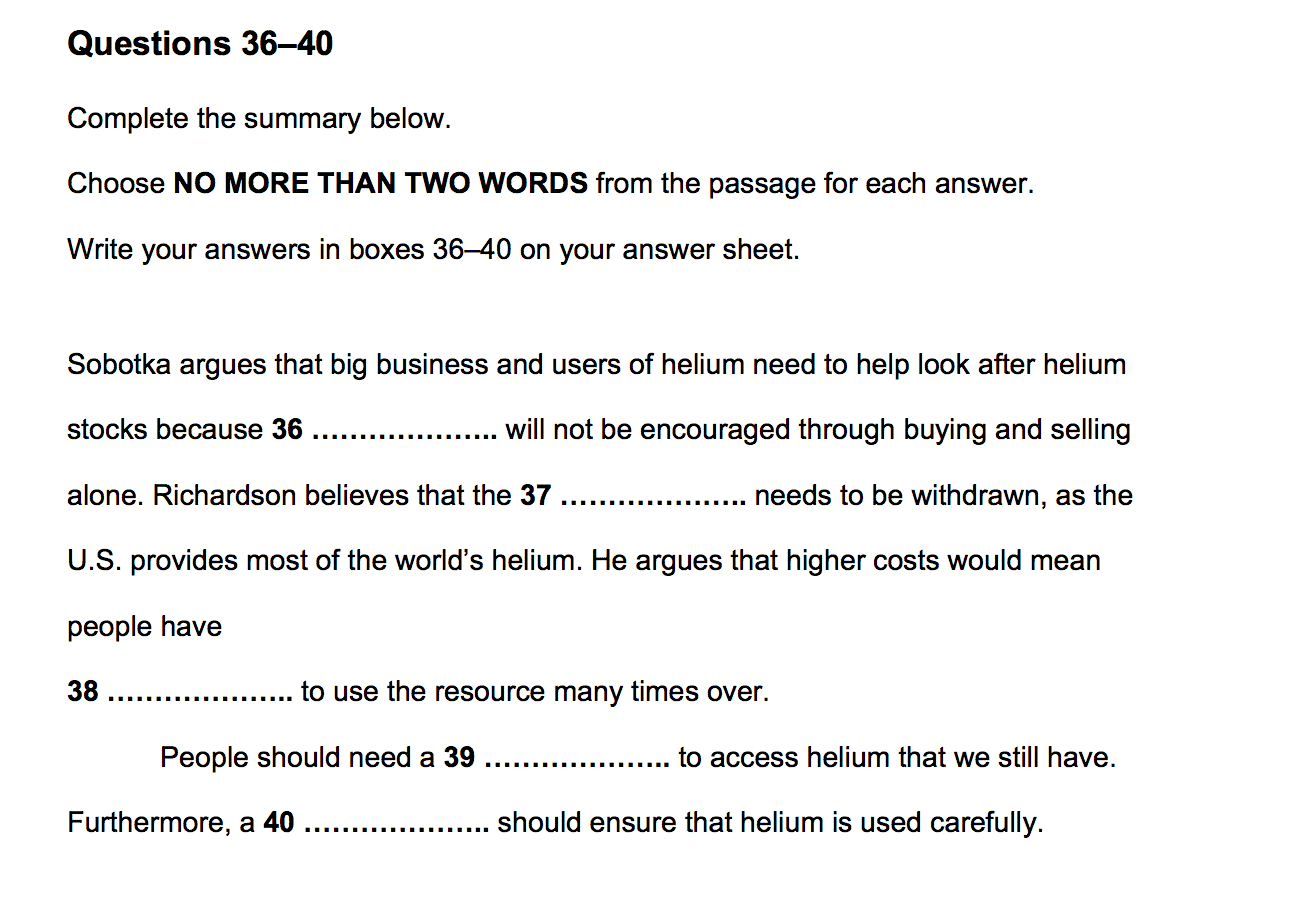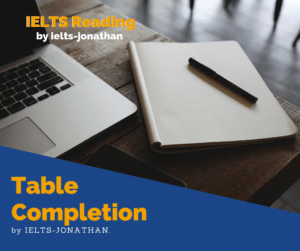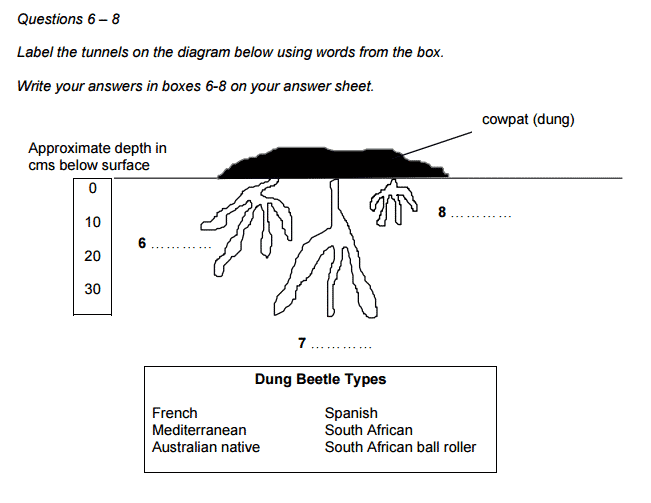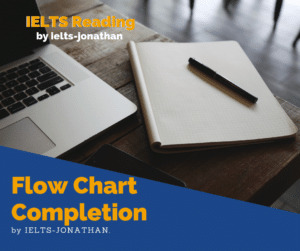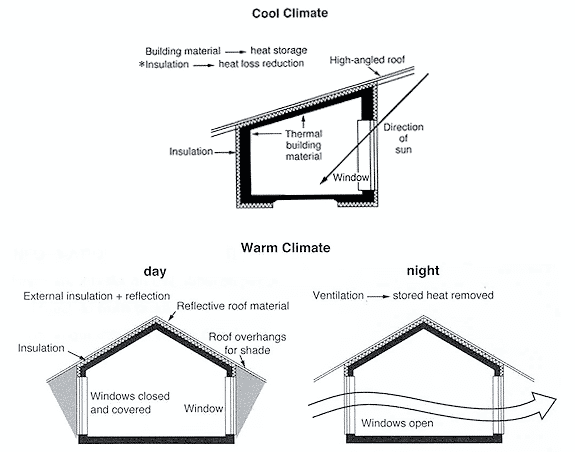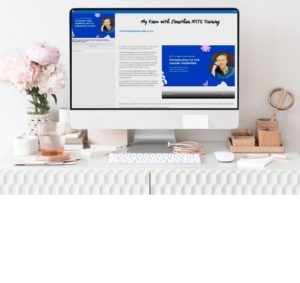Understanding what IELTS reading is and preparation?
A common question that I get asked is how can I improve my reading score and why is the reading section challenging.
My response is that there are a number of factors that make IELTS Reading a challenge, a number of things you should understand about the test and practices you should actively follow to best improve your score.
Why IELTS Reading can be challenging?
First of all and in no particular order –
- There are 3 reading passages with 40 questions to answer within 6o minutes.
- The reading passages are on Academic topics (of general interest).
- The language in the passages is Academic in style: technical, scientific and formal.
- The question format is designed to be challenging
- The questions require detailed understanding of the text and English structure.
- The passages require a high level of vocabulary and an ability to follow complex language under timed-conditions and under pressure.
- Improving your reading takes time, motivation and effort.
What should I understand?
- You should allow 20 minutes per text.
So plan your time well.
- Each question carries the same mark.
Unlike IELTS writing, you can dedicate your time equally
- Academic texts are a genre and follow a typical structure or pattern.
If you recognise the genre and structure, you are more able to find the answers quickly.
- IELTS texts often relate to similar subjects.
Study of topical vocabulary and general knowledge can help you understand concepts more easily.
- IELTS questions also follow a similar format.
If you understand how the questions work you can confidently identify the correct answer.
- Some IELTS questions always run in the order as the answers are found in the text.
You can follow the questions and the text to help you find the section you need.
How can you improve your reading?
Reading like any other skill means the more you practise, the better you get and the easier it becomes.
Improving your reading takes time, motivation and effort but I always advise students that developing a good general knowledge of topics and vocabulary will help them cope with the typical passages that come up in the IELTS Academic Reading.
In the long run, having an awareness of IELTS topics will save you time in the exam. The good news is I post articles that will help you with key topics and concepts and areas of vocabulary. Read them, note the vocabulary, and review the main arguments and ideas regularly.
I’ve also collected a series of articles that I update regularly, and all are related in some way to general IELTS topics. View my Flipboard Magazine.
If you need to improve you general reading techniques, then read this post on Reading for IELTS 7
IELTS Reading – Types of questions
In the IELTS reading section, there are 14 different types of possible questions and the test you do will have a good selection of these.
multiple choice, identifying information, identifying writer’s views/claims, matching information, matching headings, matching features, matching sentence endings, sentence completion, summary completion, note completion, table completion, flow-chart completion, diagram label completion, short-answer questions
There might be just two parts to a question or there may be five or six.
If you want to prepare for your test, you should make sure you have practised each type of question and you understand the basic principles and strategies you can use to your advantage
I have summarised the question types for you below by describing the skills you need and the tips you can use.
Heading Matching Questions
These questions may seem like a simple matching exercise, but are more complicated than that.
It’s important to understand what this kind of question is testing and some of the common issues students face if unprepared.
This is an example of a Matching Headings question.
In the first box of this question, you can see the headings you can choose from. These are numbered in Roman numerals (i -vi)
Below that , is the area where you match your heading choice with the section A, B, C etc.
These are numbered in order.
What may look like a simple task, hides many subskills which you need to utilise for a good score in this area.
To understand this, I have summarised the question type by describing these skills and provided useful tips to help you deal with this section.
As you can see, the basic task is matching the most appropriate heading (signified by numerals) to the appropriate section in the reading passage, signified by a letter.
It should be clear that how you organise your answers is important and care needs to be taken when transferring the answers, as just one mistake could ruin this section.
As well as organisational skills, the section also tests your cognitive skills.
You have to deal with multiple information such as numerals, numbers, letters, select headings and evaluate extensive text under test conditions.
What skills are needed for matching headings?
The first practical skill is to be able to skim and then scan read.
Remember that the questions do not follow the order of the passage.
You need to locate similar information, compare and select the most suitable match.
Be prepared for synonyms and also referencing words that refer forwards and backwards in the text.
For each of the five sections of the extensive reading (A – D) gaining the overall gist of the section by skimming reading will help you identify the probable headings that match the section.
Once you have an educated idea of the likely matches, then scanning takes place for specific information so you can confirm the heading is correct or not.
If you need to brush up on what these skills are, I’ve prepared a skimming and scanning post with practical explanations of these important IELTS skills.
Reading the headings quickly before reading the passage always helps. This will help you recognise the key words and synonyms from the headings. once you think you have found the correct section you can scan the keywords in the text.
Be careful, just because you see a keyword does not mean that it is the topic of the paragraph. You still need to read carefully around the text to confirm.
You should be clear there are usually more headings than you need and some of these headings might look similar so again, look carefully for distractors
You will need to check the details carefully in the reading text to confirm your decisions.
There are likely to be many new words that you are not familiar with.
Don’t be distracted by these new words.
Use the context to try and understand the general meaning, but don’t over focus on the meaning too much.
Most of the surrounding information will help you move through the text.
True, False or Not Given Questions
These questions ask you to effectively locate information in the reading passage and answer the statement after reading the details carefully.
Some people confuse True, False, Not given questions with Yes, No, Not given but the distinction is quite clear.
These questions are related to factual information. This means it will be mostly figures and facts.
True means that the statement agrees with the passage information
False mean that the statement is the opposite or contradicts the passage information
Not given is, as it says, there is no information related to the statement
You can locate the next information as you answer the next statement, they run in the same order!
You will need to skim read to locate the relevant areas of text.
When you locate the correct area of the passage, be aware that if the information is True, the wording will be paraphrased. Read that carefully!
This section means you need to scan the text for synonyms and paraphrases around these facts.
Sometimes the exact words are used in the statement and the passage.
You will need to compare the language and decide if the statement is the same (T), whether it is F ( the opposite) or if there is not enough information to form an opinion, meaning it will be NG.
YES, NO or Not Given Questions
Similar to T, F not given, you need to effectively locate information in the reading passage and answer the statement after reading the details carefully.
However, these questions are related to views, opinions, and claims rather than factual information. You need to consider and compare arguments or how ideas are presented.
Yes The views of the writer agree with the statement.
No The views of the writer are different, opposite or contradict the statement.
Not given is, as it says, there is no clear information or not enough to be sure about the views or opinions of the writer.
You can locate the next information as you answer the next statement, they run in the same order!
You will need to skim read to find the locations of relevant ideas.
When you locate the correct area of the passage, be aware that if the opinions and views are yes, then the wording will probably be paraphrased and need careful reading.
This section means you need to scan the text for synonyms and paraphrases around authors views.
Sometimes the views use the same words as in the statement and sometimes they don’t!
Scan and consider the use of synonyms and paraphrasing.
Carefully compare the language and decide if the statement is the same (Y), whether it is N( the opposite) or if there is not enough information to form an opinion, meaning it will be NG.
Always remember it’s not enough just to locate the areas of information. You are not being tested on this skill, but on your overall comprehension!
Multiple Choice.
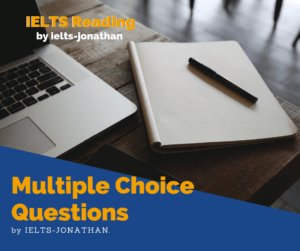
This type of question often tests your understanding of factual information in the topic rather than views or opinions.
As you can see in the example, there are five options to choose from and two answers to complete. This means that only two of the five are correct and three are wrong, incorrect or not a direct match according to the passage.
The task requires you to locate areas of the text and then examine the vocabulary carefully.
It’s helpful that the correct statements follow the order of the passage, but you will need to examine the wording carefully. It won’t be repeated in the text but the wording could be very similar.
A good way of approaching the task is to read each statement and begin skimming to locate information from the beginning. Once you have found what you think might be useful, mark it and continue reading for the next statement.
When you are reasonably certain you have identified the two statements, examine the text in more detail.
If you are not sure about a statement, try to find reasons or examples why that statement is NOT correct.
Never use your own experience or knowledge of a topic. Only examine the text with purpose of the test.
Rather than writing out the statement, you should only write the letter of the statement for 1 and 2.
If you are unable to find an answer, write something….never leave a blank space!
Sentence endings
These questions focus on understanding the views and opinions of the writer although facts and figures will be present.
You will need to correctly identify the views of the writer and also compare and contrast information which supports a view or an argument.
The question presents you with a reading passage and numbered sentence starts. These are followed by the sentence endings which are lettered.
At the end is space where you can write the letter which matches the number.
The numbers follow the order of the passage and may not contain some words from the passage. You can use these words to help identify sections which refer to the ideas in the passage.
It’s important to understand the views fully before making assumptions and matching the endings. Small words in the text may greatly change the overall meaning.
Don’t try and use grammatical knowledge to match the endings and don’t use your own experience either.
Don’t do this because
There are more options than questions and all of the sentences will grammatically fit together. Your own experience may be different to the views in the passage.
You are only focussing on matching the views and claims in the passage.
First quickly read the first half of the sentences (that’s 1, 2, 3, 4 and 5).
This will give you a very helpful idea of topic development and gist in the text
In this kind of question key words are important so underline these, as well as any names, dates or main ideas.
The questions follow the order of the passage so start reading and systematically note sections of the text which are important because of the keywords.
Don’t underline the keywords, it will make the passage messy and distracting to read.
Write a number in the margin to indicate which section you think this part of the passage refers to.
Once you have done this, go back to each section and compare the ideas with the sentence starts to confirm you are working in the right area.
Finally, move to the sentence endings and start matching these. At the same time, you can check the information agrees with the claims and views in the passage.
Although you are matching the sentence endings you should only write the letter in the answer box. Make sure it is clearly written!
Finally, remember that the sentences will appear in the text in the order of the questions so you could check your decisions again but only if you need to.
You can systematically work your way through the questions and the passage together.
Short answer
Examples of short answer questions focus on answering factual information using vocabulary taken from the reading passage.
The questions check your understanding of the subject matter and you need to write words or numbers and be specific in the amount of words you use.
Skim is an important skill in this question. You may find that similar information is repeated but you can work through the text following the questions in order.
It is important to only write the number of words specified, too many, or too few, is a wrong answer.
Most of the words you will be looking for will be nouns.
You will see that some of the words in the question may also appear in the passage.
It is important that you copy the words only as you see them in the passage paying attention to whether they are singular or plural or countable.
Don’t use your own words to complete the answer and don’t change the word form either!
Of course, spelling is important. Words that are difficult to read or spelt incorrectly are marked as wrong.
In short answer questions, reading the questions first is important.
Remember you are mostly checking facts so as you read the questions, consider the type of information you need to find, for example, a date, a time, a place, a number, a name, a location.
- Read questions first and note the information you are looking for
- Read the passage and questions in order
- Locate the likely information and double check
- Write the answer exactly as you see it
- Check you have not written too many or too few words.
Sentence completion
In this task, the questions test your ability to locate and record factual subject specific information. These can be words or numbers.
The statements will not have the same words as in the passage, but the information will be the same.
The instructions tell you how many words you should write , for example, ‘Choose NO MORE THAN ONE WORD AND/OR A NUMBER’.
You should write the words as you see them. Don’t change the word form.
Read the questions first and note the type of information you are locating.
For example, grammatically the gaps below could be filled by one noun and one verb.
Chomsky’s’ findings are regarded as important in the field of ……. (linguistics)
The publisher was nearly ……. due to the poor response to the publication. (bankrupted)
Note how the words in the question could produce a number of synonyms in the passage.
For example, the ‘field of’ could produce an area of, study of or in the discipline of in the passage.
Gaps, however, could be as easily filled by compound nouns of more than one word.
‘Choose NO MORE THAN TWO WORDS AND/OR A NUMBER’.
Participants were reminded that …………. was at a certain time.
The results of Preston’s study indicated that the growth of plants accelerated at the time of a …………..
It would seem that just by increasing the number of ………….. did not correlate with the increased number of weekend passengers.
Check out full moon bus stop
Don’t write numbers as individual words, write them as the number, like this – 256.
The first step is to read the questions quickly.
When you move onto the passage you will probably notice there are a number of words that could grammatically fit each question statement, area of, study of.
There may be a number of distractors in the passage so it’s important that you check carefully the words you have chosen exactly report the passage.
Go through the passage as you go through the questions, remember the questions are in the order of the passage.
Don’t just write down the first word that grammatically fits, think carefully about the meaning and the number of words that fit.
If you do struggle with an answer, always write something in the space for answers and never leave a blank!
After all, your guess could be correct!
Matching features
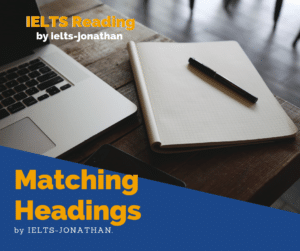
The task confuses students because there are two different types of question which look very similar to each other but come under the same question classification.
It can be tricky to understand at first but with practice you will create a good habit and you can focus on the task itself.
The question tests whether you can understand the main ideas, in addition to understanding more detailed information and arguments in the passage.
Although you may see differences in the tasks format, they are really testing the same reading skills and in the same way.
When you come to practice these questions, one way to spot the difference is that the first question features numbered statements.
Question type 1
In this question set there will be a number of statements. It is important to remember that these statements do not come in the order of the passage, although they are numbered, they are arranged randomly.
The statements will not use words and phrases from the passage, but of course they will refer to information and ideas in the text.
The answers, which go with the statements, are lettered, so you answer the question by placing the appropriate letter against the numbered statement.
So A) London B) Paris and C) Madrid, are matched to statements 1, 2 ,3 etc.
All the letters need to be used and letters can be used more than once
The second question type is recognisable by numbered sets of features.
Question type 2
In this question set, instead of statements, there will be a number of features.
It tests whether you can locate the main theories discussed in the text.
The answers appear as the statements are ordered in the text.
As an example, these could a be a list of names, companies or organisations connected to the text.
There will also be a box that contains the options to work with.
In this example, the task would be to match the name to the theory or contribution to science
For example, the feature could be an airline manufacturer and its contribution to aero science like this for example.
Boeing, Vickers, Bell, Airbus, match to 1, 2, 3 which is a contribution to airline development mentioned in the reading.
Remember, these features are ordered as they appear in the passage, they are not random.
As before, the answers, which go with the statements, are lettered. To answer, place the appropriate letter against the numbered statement.
All the letters need to be used but in this question the letters cannot be used more than once.
How to answer both types of question
In both questions you should read the statements and features first of all. This will give you some gist of what you are going to read about.
Then begin reading the passage but as you do so, note with an underline phrases where you see information directly related to a feature in the text or mark sections where you see information related to statements.
You are likely to mark more than one phrase or section, so the second stage is to begin looking more carefully to see if the ideas match more precisely. Remember the second type of question has two parts that need to match together.
Always write an answer and don’t leave a blank.
Matching information
In this task, individual paragraphs are numbered. It might look like the principle is to match statements ( 1 – 7 for example) with the main ideas of the paragraph.
The statements are likely to deal with more detailed information and arguments than just the main idea.
Although the paragraphs (and the letters) are in order, the statements (and numbers) are not, they are randomly ordered.
As with other tasks, although the wording refers to ideas in the passage, the wording is not the same.
A good point about the statements is that they indicate the type of information you need to search for. Examples in past papers have been an example, a reference, the realisation, the idea, so it’s important to check these first and then note what kind of example or reference you are looking for.
You write the letters next to the numbered statement.
So, first of all, read the statements and note the kind of information you will be looking for, whether it is an example, an idea or prediction.
Read the text quickly and mark the passage where you feel the information you are looking for can be found. Note that there may be more than one example of the kind of information that you need to find; there may be more than one prediction or reference in the same paragraph.
Also be aware that lettered paragraphs may contain information on more than one statement so you may read the same section twice for a different reason or you may not read a paragraph at all.
If you have any statements left unanswered, write a letter anyway.
Don’t lose points for a no answer so don’t leave a section blank.
Summary completion
The main testing principle is dealing with two extensive sections of text on the same topic, locating factual information and checking details against both texts.
The longer text is the original material and the shorter one is a summary of the main points, much like summary notes you might write at university.
While the summary reports the main ideas from the longer text, the information may not be in the same order as the original so you cannot systematically read both texts together.
You will need to check the instructions as you may need to write more than one word, like this ‘Choose NO MORE THAN TWO WORDS AND/OR A NUMBER’
To complete this task read the summary first noting the main ideas and key words. This will help indicate the type of information that is missing, for example, numbers, a name or something specific.
You may see that part of the summary refers to the meaning of the passage rather than specifics within the passage.
Then begin reading the longer text, noting the main words, ideas and key words from that text.
Return to the summary, focus on each gap in the text, and return to read the main passage sections you think deals with this.
There will often be clues in the summary that indicate the type of information you are looking for.
For example, the phrase
‘as far back as’
indicates you are looking for a time period, more specifically a date, these phrases,
‘figures indicate a sharp decline in ………’ ‘this increased by around…….’
indicate you are looking for (1) a noun or noun phrase and (2) a number.
It may not be as easy as this in the reading and there may be, for example, many numbers so you do need to read around the main passage to check.
Hopefully as you read, you will begin to see the words you need to write.
Copy the word exactly as you don’t need to change them in any way. They will grammatically fit but remember the number of words you need to write and check your spelling is the same.
Don’t use the spelling you are used to, use the spelling from the text.
A word could be a number so write it exactly as you see it, like this, 257, as a number.
Finally, you will need to transfer the ‘words or numbers’ to the answer sheet so the spelling on the answer sheet needs to be checked again.
Question Set 3 Notes, Tables Diagrams and Flowcharts.
The final set of questions may or may not come in the order of the passage.
As the content and strategies to follow are broadly similar, they have been grouped together.
Any differences are highlighted in the following text.
All of these tasks ask you to locate specific information from reading passages and record it accurately. These tasks test your understanding of factual information on a specific subject topic. So the text will have many facts about the subject.
You will find information related to the passage in the form of a table, notes of a diagram etc, and using information from the passage you need to complete gaps in the text.
As with other tasks, you need to write words or numbers to complete these gaps.
We can regard all of these tasks as a note taking task:
Notes can take the form of:
A set of notes in a table
A set of notes under headings
A pictorial diagram or flowchart with associated labels for making notes
Always prepare yourself by looking at the notes before you begin to look at the passage.
For information in a table, read the information from left to right and not top down and you usually follow the order of the passage.
Labels on diagrams go in clockwise order around the diagram and a bonus is the question numbers follow the order of the passage.
A flowchart is as it describes, so you should follow it from start to finish.
How to approach these tasks
When you look at the notes, think about the kind of information you will need to complete it and check the number of words.
The majority of the missing words are about facts so will likely be nouns or compound nouns, but not always.
When you move to the passage, you will find that a number of words could grammatically fit so you need to double-check the words you choose are the correct choices and report the intended meaning.
When you have decided on the correct words, write them in the gaps.
Don’t change them in any way, they are to be used as they are seen and make sure your writing is legible.
Spelling errors and words that can’t be read clearly are marked as wrong.
Remember that …
Dealing with a large text and 14 types of question format can be a real challenge.
A good way to make the task less daunting is to become an expert in understanding the kind of skills each task is designed to test.
A question that may appear to be a simple task will have a test principle behind it and so it may not be a simple as it appears.
Solution
If you understand the testing principle, it will help you complete the activity easier and the task easier.
You will also understand and avoid the problems that the majority of test-taker’s experience. 🙂
Academic Reading Links
Texts for the Academic Reading test are taken from books, journals, magazines and newspapers.
A variety of tasks is used, including:
multiple choice questions, identifying information, identifying writer’s views/claims, matching information, matching headings, matching features, matching sentence endings, sentence completion, summary completion, note completion, table completion, flow-chart completion, diagram label completion, short-answer questions.
| Downloadable Academic Reading sample tasks |
|---|
| Academic Reading sample task – Diagram label completion (PDF, 61KB) |
| Academic Reading sample task – Matching information (PDF, 35KB) |
| Academic Reading sample task – Identifying writer’s views (PDF, 56KB) |
| Academic Reading sample task – Matching features (PDF, 22KB) |
| Academic Reading sample task – Matching headings (PDF, 26KB) |
| Academic Reading sample task – Multiple-choice questions (PDF, 21KB) |
| Academic Reading sample task – Table completion (PDF, 59KB) |
| Academic Reading answer sheet |
|---|
| IELTS Reading answer sheet (PDF, 130KB) |
General Reading Links
A variety of tasks is used including:
multiple choice questions, identifying information, identifying writer’s views/claims, matching information, matching headings, matching features, matching sentence endings, sentence completion, summary completion, note completion, table completion, flow-chart completion, diagram label completion, short-answer questions.
| Downloadable General Training Reading sample tasks |
|---|
| General Training Reading sample task – Flow Chart Completion (PDF, 40KB) |
| General Training Reading sample task – Identifying Information (PDF, 99KB) |
| General Training Reading sample task – Matching Information (PDF, 43KB) |
| General Training Reading sample task – Matching Features (PDF, 32KB) |
| General Training Reading sample task – Matching Headings (PDF, 31KB) |
| General Training Reading sample task – Multiple-Choice Questions (PDF, 24KB) |
| General Training Reading sample task – Sentence Completion (PDF, 19KB) |
| General Training Reading sample task – Short-Answer Questions (PDF, 18KB) |
| General Training answer sheet |
|---|
| IELTS Reading answer sheet (PDF, 130KB) |

